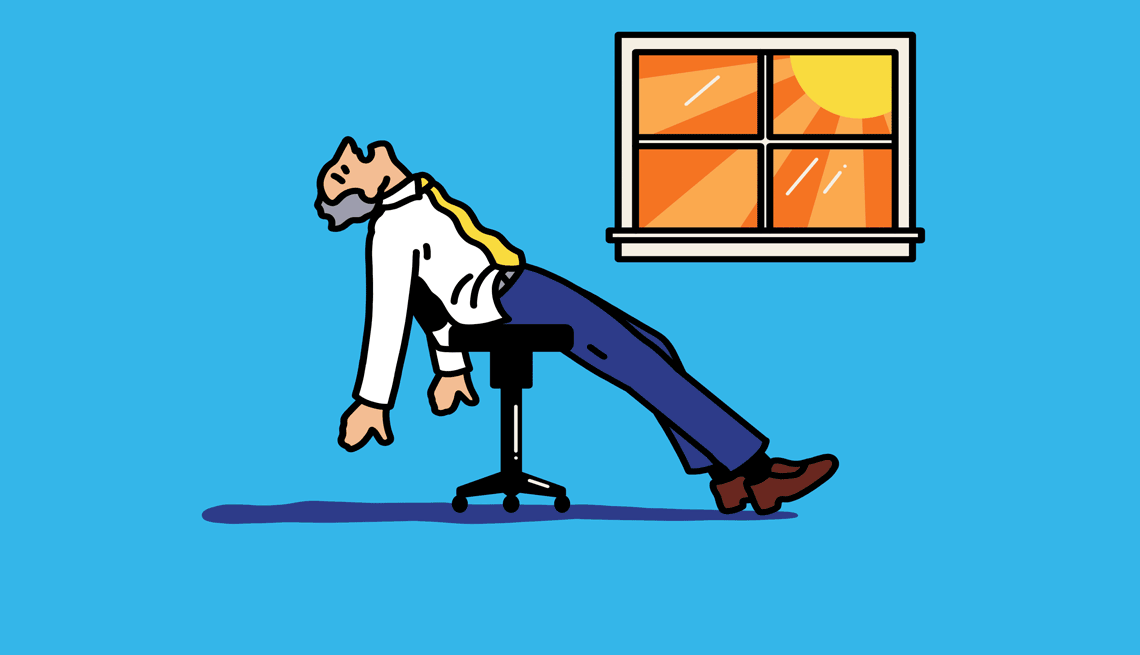
- Select a language for the TTS:
- UK English Female
- UK English Male
- US English Female
- US English Male
- Australian Female
- Australian Male
- Language selected: (auto detect) - EN
Play all audios:
If you’ve been feeling stressed or anxious at work lately, you’re not alone. More than half of Gen Xers and a third of boomers are facing moderate to high levels of burnout, according to the
2023-2024 Aflac WorkForces Report. The report, which surveyed 2,000 workers and 1,200 employers, also found that 89 percent of those who felt burnout at work also experienced anxiety,
depression and weight gain and had trouble sleeping outside the workplace. Depression and burnout share some similarities, but burnout is really defined by three things, says sociologist
Tracy Brower, author of _The Secrets to Happiness at Work: How to Choose and Create Purpose and Fulfillment in Your Work._ First, job burnout includes feelings of being trapped, like there’s
nowhere to go and no progress is being made. Second, it includes cynicism. Lastly there’s an element of feeling not good enough or never measuring up. “That ends up making people feel
exhausted or depressed, or kind of up against a wall,” she says. Stress on the job can sometimes cause older adults to reduce hours, switch careers or retire early. Before taking one of
those bigger steps, take a moment to explore the causes of your job frustration and fatigue. While there’s no quick fix for burnout, here are 25 ways you can take action to feel better in
the moment, along with some longer-term steps you can take to help improve the situation at work. 1. TACKLE THE TOUGH TASKS FIRST Brain wellness researcher Rebecca Jackson suggests taking on
the things you may not like to do first. “We’re going to avoid the things that we don’t like doing, and so that’s going to be lingering in the background of your head of dread, and we’re
going to have the most energy and focus and resources first thing in the day, so start with your hardest and most complex tasks, or the things that you like the least when you’ve got the
energy and resources to do it,” she says. 2. TRY 4-7-8 BREATHING Different types of breathing exercises can improve your body’s reaction to stress, says Marissa Alert, a licensed clinical
health psychologist who helps businesses manage their employees’ stress and burnout. She suggests exercises such as 4-7-8 breathing, in which you inhale for four seconds, hold that breath
for seven seconds, then exhale slowly for eight seconds. A 2022 clinical study published by _Obesity Surgery Journal_ conducted with 90 people who recently had bariatric surgery says, “The
4-7-8 breathing technique was found to be beneficial in reducing the anxiety level of patients.... It was found that deep breathing exercise was also effective in improving the quality of
life.” Breathing exercises can be “a really helpful way to downregulate to get in a better mindset,” Alert adds. Another exercise is cyclic sighing, which can produce mental and physical
benefits that “appear to last over time,” according to a January 2023 study published in Cell Reports Medicine. Cyclic sighing involves first inhaling deeply through the nose, followed by
another short inhale, then slowly exhaling through your mouth. You might try box breathing, which is four equal steps of inhale, hold, exhale, hold — like the four sides of a square. 3.
TAKE — OR PLAN — A VACATION Taking time off and disconnecting from work is also important, Brower says. One 2023 study in the _Harvard Business Review_ found that sabbaticals can be powerful
burnout-prevention tools. Even if you can’t take a vacation now, planning something you can look forward to — an enjoyable outing or event — may offer some relief. “[I]t has been shown
that planning something fun is almost as beneficial to the brain as actually engaging in the activity itself, engaging the same neurotransmitters and pathways in the brain,” says Jackson.
4. SPEND 30 MINUTES OUTDOORS Spending time outdoors also can be restorative. A July 2022 study published in _Frontiers in Psychology_ found that spending time outside can bolster mental
well-being. The researchers surveyed 507 staff members at a large university in New York state and found that “[t]he majority of respondents also identified that they generally feel happier,
less stressed, less anxious, and refreshed after spending time outdoors in nature.” Most of those respondents said they were spending as little as 15 or 30 minutes outside when they went
out. Whether you take a walk in a park, grab lunch outdoors or step out for a breath of fresh air, you can give yourself a boost. Researchers found that microbreaks of as little as 10
minutes can help reduce fatigue. Sam Island 5. TAKE MICROBREAKS Breaks are important to stave off burnout. But the length of the break matters, depending on what you’re doing. Researchers
found that microbreaks of as little as 10 minutes can help reduce fatigue, but only if you use them to do something less taxing than what you already were doing, according to the August
2022 study published in the _PLOS One_ journal. Microbreaks “make individuals feel more vigorous and less fatigued and stimulate them to feel more productive after the break,” the study
says. 6. EAT WHITE MEAT, VEGETABLES AND BERRIES A study published in the July 2021 issue of the journal _Nutrients_ found that among 630 Finnish women workers, those who ate healthier diets
were less likely to feel burnout at work. Those women more often ate low-fat dairy, produce, vegetables, fruit and berries, and white meat. Even when you know a balanced diet is
essential for your wellness, it’s easy to let it slip when work keeps you busy. Alert, the clinical psychologist, says that taking care of “the things most people know” (but many of us fail
to do) is important. All these things can help you better deal with stressors that can contribute to burnout, she says. 7. WALK OR STRETCH FOR 10 MINUTES Getting up from your desk and
moving around regularly can help alleviate the symptoms of burnout and feeling overwhelmed, says therapist Kelley Bonner, founder of Burn Bright Consulting, an employee wellness firm that
has worked with the U.S. military, the United Nations and the Library of Congress. A five-minute walk or a few stretches are some quick workplace exercises that can help you feel better.
“Even a walk to the coffee machine or to get a change of scenery can help because, oftentimes, we work past the point of productivity,” she says. Jackson agrees, adding that “exercise and
engaging our muscles and elevating the heart rate is one of the most powerful tools that helps us reset the brain back to positive.”









